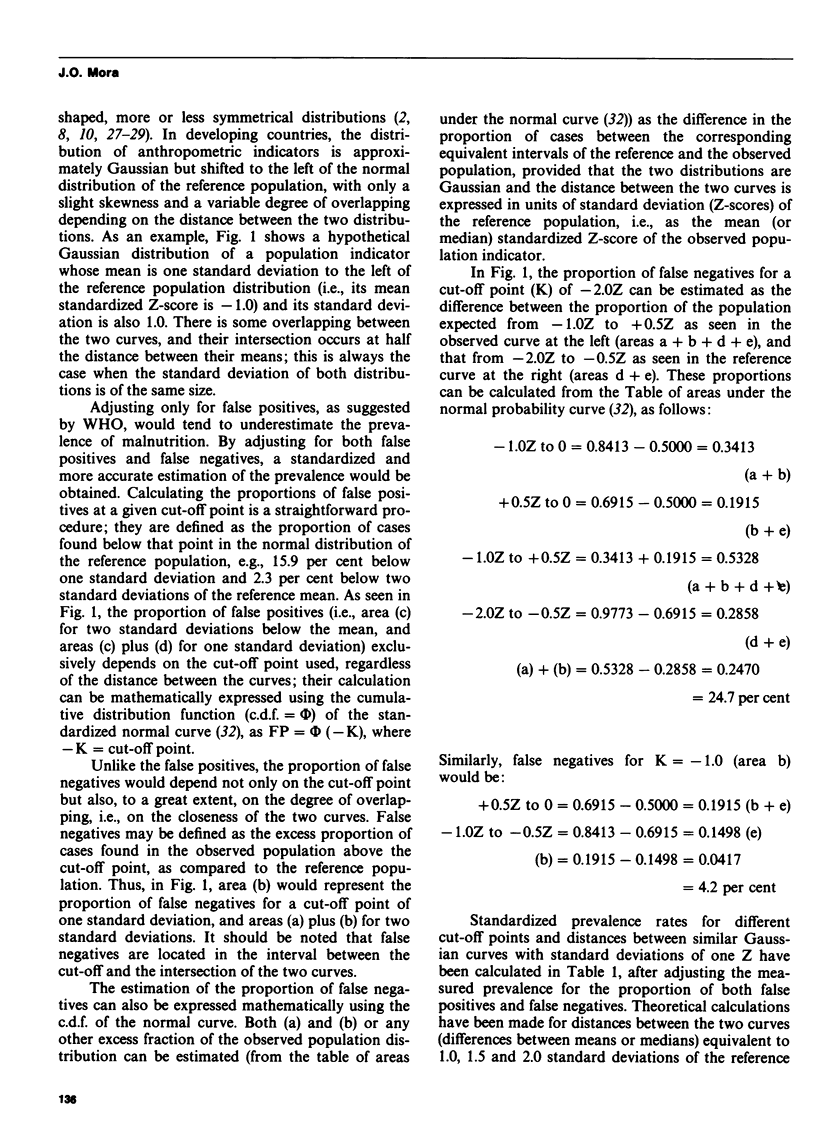Abstract
Although anthropometric indicators are widely used for assessing the nutritional status of children, lack of consensus on the cut-off points for prevalence estimates has precluded the use of standard analytical methods in population surveys. A simple method for estimating a standardized prevalence of child malnutrition from anthropometric indicators is presented. The method is based on comparing the distribution of the indicator with that of the normalized NCHS reference population, the underlying assumption being that both distributions are nearly normal. Standardized prevalence is defined as the proportion of cases in the observed population that is outside the normal distribution of the reference values, which can be estimated from the mean and standard deviation of the standardized Z-scores of the population, by using a formula based on the mathematical properties of the normal probability curve. A reference table is included which provides computer-estimated prevalence rates for different mean Z-scores and standard deviations of normally distributed anthropometric indicators.
Full text
PDF









Selected References
These references are in PubMed. This may not be the complete list of references from this article.
- Bengoa J. M. Recent trends in the public health aspects of protein-calorie malnutrition. WHO Chron. 1970 Dec;24(12):552–561. [PubMed] [Google Scholar]
- Chen L. C., Chowdhury A., Huffman S. L. Anthropometric assessment of energy-protein malnutrition and subsequent risk of mortality among preschool aged children. Am J Clin Nutr. 1980 Aug;33(8):1836–1845. doi: 10.1093/ajcn/33.8.1836. [DOI] [PubMed] [Google Scholar]
- Cook J. D., Alvarado J., Gutnisky A., Jamra M., Labardini J., Layrisse M., Linares J., Loria A., Maspes V., Restrepo A. Nutritional deficiencey and anemia in Latin America: A collaborative study. Blood. 1971 Nov;38(5):591–603. [PubMed] [Google Scholar]
- Dibley M. J., Goldsby J. B., Staehling N. W., Trowbridge F. L. Development of normalized curves for the international growth reference: historical and technical considerations. Am J Clin Nutr. 1987 Nov;46(5):736–748. doi: 10.1093/ajcn/46.5.736. [DOI] [PubMed] [Google Scholar]
- Dibley M. J., Staehling N., Nieburg P., Trowbridge F. L. Interpretation of Z-score anthropometric indicators derived from the international growth reference. Am J Clin Nutr. 1987 Nov;46(5):749–762. doi: 10.1093/ajcn/46.5.749. [DOI] [PubMed] [Google Scholar]
- Garby L., Irnell L., Werner I. Iron deficiency in women of fertile age in a Swedish community. 3. Estimation of prevalence based on response to iron supplementation. Acta Med Scand. 1969 Jan-Feb;185(1-2):113–117. doi: 10.1111/j.0954-6820.1969.tb07305.x. [DOI] [PubMed] [Google Scholar]
- Habicht J. P., Meyers L. D., Brownie C. Indicators for identifying and counting the improperly nourished. Am J Clin Nutr. 1982 May;35(5 Suppl):1241–1254. doi: 10.1093/ajcn/35.5.1241. [DOI] [PubMed] [Google Scholar]
- Habicht J. P. Some characteristics of indicators of nutritional status for use in screening and surveillance. Am J Clin Nutr. 1980 Mar;33(3):531–535. doi: 10.1093/ajcn/33.3.531. [DOI] [PubMed] [Google Scholar]
- Keller W., Fillmore C. M. Prevalence of protein-energy malnutrition. World Health Stat Q. 1983;36(2):129–167. [PubMed] [Google Scholar]
- Kielmann A. A., McCord C. Weight-for-age as an index of risk of death in children. Lancet. 1978 Jun 10;1(8076):1247–1250. doi: 10.1016/s0140-6736(78)92478-9. [DOI] [PubMed] [Google Scholar]
- McLaren D. S., Read W. W. Classification of nutritional status in early childhood. Lancet. 1972 Jul 22;2(7769):146–148. doi: 10.1016/s0140-6736(72)91324-4. [DOI] [PubMed] [Google Scholar]
- Meyers L. D., Habicht J. P., Johnson C. L., Brownie C. Prevalences of anemia and iron deficiency anemia in Black and White women in the United States estimated by two methods. Am J Public Health. 1983 Sep;73(9):1042–1049. doi: 10.2105/ajph.73.9.1042. [DOI] [PMC free article] [PubMed] [Google Scholar]
- Sykes P. A. Errors arising through using the Harvard tables and percentage levels of median weight-for-age in assessing nutritional status. Arch Dis Child. 1977 May;52(5):391–394. doi: 10.1136/adc.52.5.391. [DOI] [PMC free article] [PubMed] [Google Scholar]
- Waterlow J. C., Buzina R., Keller W., Lane J. M., Nichaman M. Z., Tanner J. M. The presentation and use of height and weight data for comparing the nutritional status of groups of children under the age of 10 years. Bull World Health Organ. 1977;55(4):489–498. [PMC free article] [PubMed] [Google Scholar]
- Waterlow J. C. Classification and definition of protein-calorie malnutrition. Br Med J. 1972 Sep 2;3(5826):566–569. doi: 10.1136/bmj.3.5826.566. [DOI] [PMC free article] [PubMed] [Google Scholar]


